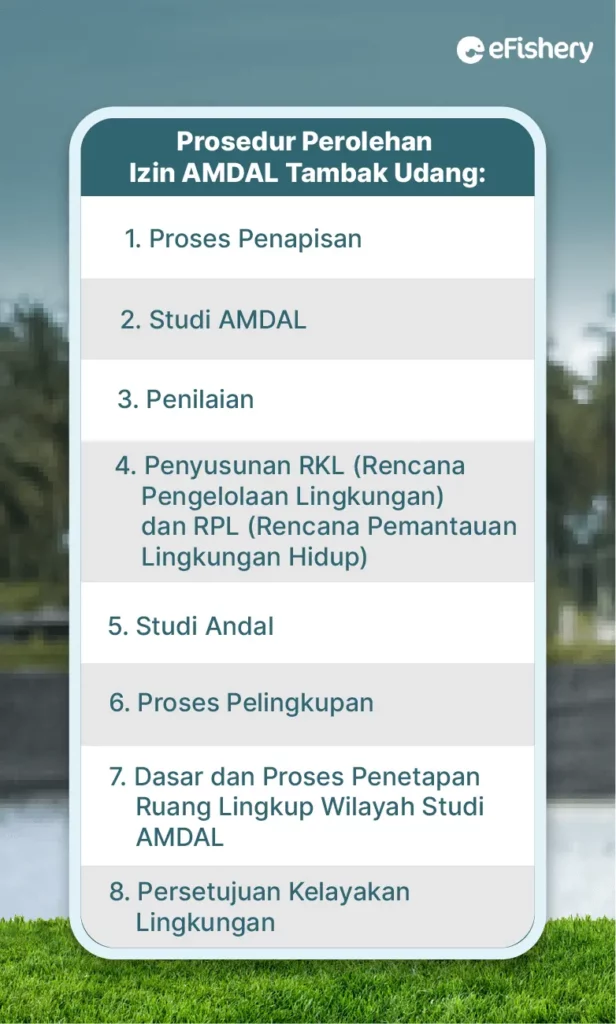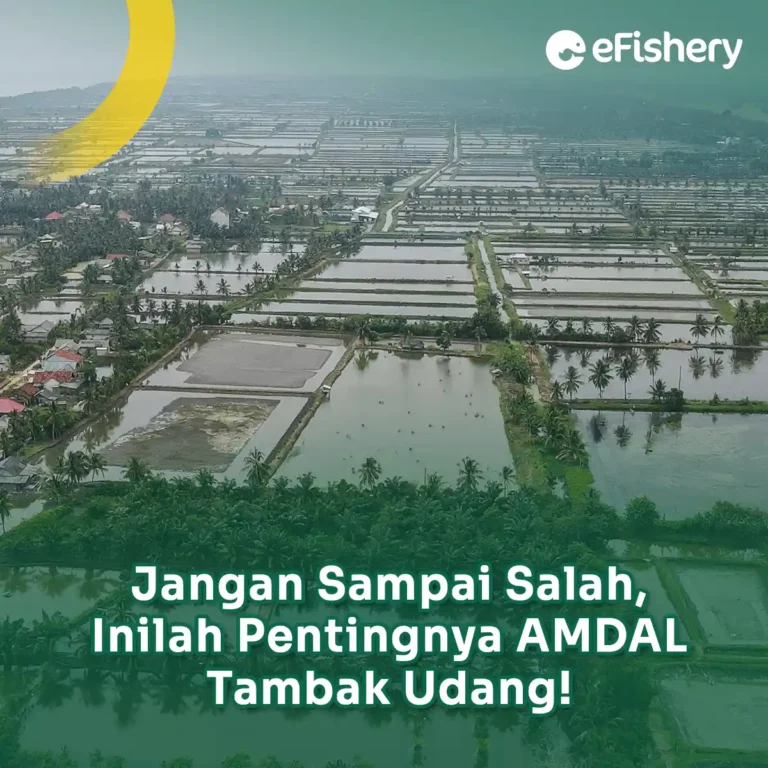Artikel Ini Telah Direview Oleh:

Nabilla Anggi
Magister Budidaya Perairan
Maybe not many farmers are familiar with the EIA for shrimp ponds. In fact, it is necessary to have an AMDAL permit for shrimp ponds, whether it is a pond for freshwater, brackish or marine shrimp cultivation. Check out the full explanation here!
What is EIA?
AMDAL or Environmental Impact Analysis is a study of the impact of a planned business and/or activity on the environment. AMDAL is very necessary as a decision-making process regarding the implementation of business/activities, whether the planned activities/businesses are environmentally feasible or not.
In Article 33 paragraph (4) of the 1945 Constitution of the Republic of Indonesia "... The use of natural resources should be based on three pillars of sustainable development, namely economically viable (economically profitable), socially acceptable (socially acceptable), and environmental sound (environmentally friendly)…".
Based on this explanation, the existence of an AMDAL for your shrimp cultivation is important because the AMDAL can show whether your shrimp farming plan has fulfilled the three pillars of sustainable development.
The Importance of EIA in Shrimp Cultivation
Shrimp cultivation is a business whose processes and activities can affect the surrounding environment. The shrimp farming process produces waste from leftover feed and shrimp excrement which can pollute the environment, cause bad smells, and become toxic to other biota if not treated properly. Therefore, an AMDAL is needed to protect shrimp farming and minimize adverse impacts on society and the environment.
EIA Preparation Requirements for Shrimp Cultivation
The following are the criteria for making an EIA for shrimp farming:
- Individuals who cultivate shrimp with an area of less than 10 ha must register their business with the local Regency/City Office.
- Every company that conducts cultivation business with an area of 50 ha or more is required to apply the Community Core Pond (TIR) pattern in accordance with the provisions of the applicable laws and regulations.
- Shrimp cultivation businesses with an area of 50 ha or more are required to carry out an Environmental Impact Analysis (AMDAL) study in accordance with the provisions of the applicable laws and regulations.
So, those of you who are planning to build a shrimp pond with an area of 50 ha or more are required to have an AMDAL. However, if the area is less than 10 ha, you are only required to register your business with the local office.
Contents of the EIA document
The preparation of the AMDAL document refers to the Regulation of the State Minister for the Environment Number 16 of 2012 concerning Guidelines for Preparing Environmental Documents. Following are the details of the AMDAL documents:
- KA-ANDAL Document (Terms of Reference for Environmental Impact Analysis)
- ANDAL Document (Analysis of Environmental Impacts)
- RKL Document (Environmental Management Plan)
- RPL Document (Environmental Monitoring Plan)
EIA Permit Obtaining Procedure

You can get an AMDAL permit after going through several procedures. The procedure for obtaining an AMDAL permit is as follows:
1. Screening Process
This stage is needed to find out whether the development plan or activity requires an AMDAL or not.
2. EIA Study
The AMDAL study is a pre-field study as well as a literature study related to the typology of the activity/business plan and the typology of the environment or where the activity/business is carried out. The pre-field study stage must produce KA-ANDAL (Terms of Reference for Environmental Impact Analysis).
3. Assessment
At this stage, KA-ANDAL will be assessed by the AMDAL assessment commission and stakeholders (stakeholders). If approved, the KA-ANDAL is determined as a frame of reference for conducting an Environmental Impact Analysis (ANDAL) study.
4. Preparation of RKL and RPL
Once the ANDAL has been approved, the next stage is the preparation of an Environmental Management Plan (RKL) and an Environmental Monitoring Plan (RPL).
5. The ANDAL study
During the process of preparing the RKL and RPL documents, the following activities will also be carried out:
- Identify potential impacts
- Evaluation of potential impact
- Determination of significant impact hypothetical
- Testing and analysis of environmental typology data that will be affected
- Improving alternative activity/business plans to minimize environmental impacts that will occur
6. Scoping Process
This process is an identification of potential environmental impacts resulting from the influence of a planned development activity/business. This stage consists of:
- Identify potential impacts
- Evaluation of potential impact
- Concentration of large and important impacts (focusing)
7. Basis and Process for Determining the Scope of the AMDAL Study Area
This is intended to limit the size of the ANDAL study area that is included in the AMDAL document. The scope of the ANDAL study area consists of four boundaries, namely, project, ecological, social, and administrative boundaries.
8. Approval of Environmental Feasibility
Decisions on the environmental feasibility of an activity or business plan are issued by:
- Minister, if the document is assessed by the central appraisal commission,
- Governor, if the document is assessed by the provincial appraisal commission, and
- Mayor/Regent, if the document is assessed by the city/regency appraisal commission.
EIA Consultation for Shrimp Ponds and Shrimp Farming at eFarm!
Need Help Regarding Shrimp Cultivation Business?
Fill in your personal data in the following form. Our team will immediately contact you via the number cellphone attached. Make sure the data entered is correct.
An Environmental Impact Analysis (AMDAL) needs to be carried out when planning a shrimp farming business to prevent the possibility of bad things happening which will have an impact on the surrounding environment. For those of you who want to make a shrimp farming business plan and need the opinion of a shrimp farming expert, the solution is eFarm!
eFarm is a shrimp farming application that provides solutions to various shrimp farming problems, both for prospective farmers, experienced technicians, or senior farmers. This application aims to assist you in realizing optimal cultivation results.
eFarm has several mainstay features, one of which is Cultivation Consultation. Through this feature, you will get answers to all your questions about shrimp farming, directly from the experts!
Easy, fast and free consultation through the application eFarm!

Nabilla Anggi - Magister Budidaya Perairan
Nabilla merupakan lulusan sarjana dan magister budidaya perairan serta memiliki pengalaman di dunia perikanan baik hatchery maupun pembesaran
Questions Regarding the EIA for Shrimp Ponds
In accordance with applicable regulations, an AMDAL study must be carried out on shrimp farming businesses that have an area of 50 ha or more.
AMDAL or Environmental Impact Analysis is a study of the impact of a planned business and/or activity on the environment. EIA is very necessary as a decision-making process regarding the implementation of a business/activity to determine whether the planned activity/business is environmentally feasible or not.
- Marine and Fisheries Ministry. 2004. General guidelines for shrimp farming in ponds. 26 p.
- Rizal, R. 2016. Environmental Feasibility Study (AMDAL, UKL-UPL and SPPL). Jakarta: Publishing Institute for Research and Community Service at the National Development University "Veteran" Jakarta. 226 pp.
- Regulation of the Minister of State for the Environment of the Republic of Indonesia. 2016. Guidelines for Preparing Environmental Documents.
